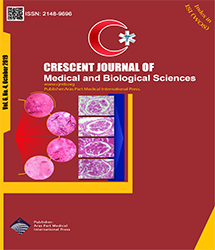
| Original Article | |
| Safety Evaluation of Tricalcium Phosphate/Collagen Nanocomposite Scaffold in Bone Defect in New Zealand White Rabbit Model | |
| Hanie Farahi1, Seeyamak Mashhady Rafe1, Alireza Jahandideh2, Ahmad Asghari2, Seyed Hamed Shirazi-Beheshtiha3 | |
| 1Department of Small Animal Internal Medicine, Faculty of Veterinary Medicine, Science and Research Branch, Islamic Azad University, Tehran, Iran 2Department of Veterinary Surgery, Faculty of Veterinary Medicine, Science and Research Branch, Islamic Azad University, Tehran, Iran 3Department of Clinical Sciences, Faculty of Veterinary Medicine, Karaj Branch, Islamic Azad University, Karaj, Iran |
|
|
CJMB 2019; 6: 449–454 Viewed : 4120 times Downloaded : 2996 times. Keywords : Tricalcium phosphate/collagen, Nanocomposite, Biocompatibility, Oxidative stress, Bone defect |
|
| Full Text(PDF) | Related Articles | |
| Abstract | |
Objectives:Bone loss with skeletal trauma or metabolic diseases usually will require a bone graft. In addition, medical devices used for replacement in tissues such as bones and cartilages for more than 30 days must be checked and controlled for biological safety. Materials and Methods: New Zealand white rabbits were divided into two groups. The frst group had no defects and was selected as the control group. In the experimental group, tricalcium phosphate/collagen (TCP/collagen) nanocomposite was utilized as the replacement tissue in the femoral defect site. Then, the factors of kidney, liver, and TCP/collagen biocompatibility were evaluated drawing on hematological quality. Free radicals are generated by the damaged tissue when there is a fracture in a bone. Oxidative stress is involved in this mechanism which is defned as the excessive imbalance of reactive oxygen species (ROS) and inappropriate antioxidant anti-mechanical mechanisms. Results: In the treatment group, malondialdehyde (MDA) level increased postoperatively in the 15th and 30th days, but in due course, it reduced on days 45 and 60. Further, glutathione peroxidase (GPX) enzyme increased after the surgery on days 15 and 30 in the test group and superoxide dismutase (SOD) enzyme demonstrated a slight increase in 15th day. The hematologic investigations were all within a normal limit, including hepatic enzymes, alanine transaminase, aspartate aminotransferase, and alkaline phosphatase (ALP), which indicate the liver damage, as well as creatinine and urea levels displaying the renal function. Conclusions: Overall, the results of the current study revealed that the oxidative stress factor in the treatment group was not higher compared to the control group, thus showing good biocompatibility of TCP/collagen nanocomposite. |
Cite By, Google Scholar
Google Scholar
PubMed
Online Submission System
 CJMB ENDNOTE ® Style
CJMB ENDNOTE ® Style
 Tutorials
Tutorials
 Publication Charge
Medical and Biological Research Center
About Journal
Publication Charge
Medical and Biological Research Center
About Journal
Aras Part Medical International Press Editor-in-Chief
Arash Khaki
Deputy Editor
Zafer Akan


















